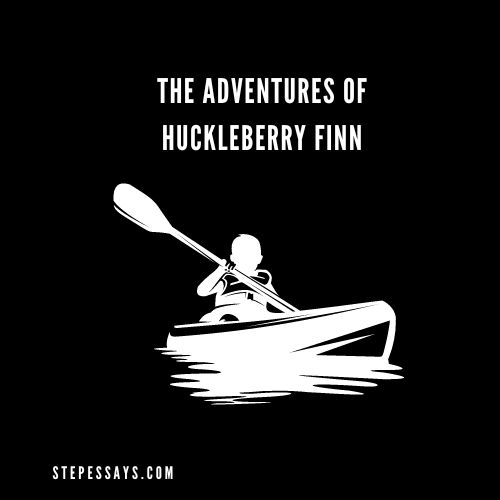Table of Contents
ToggleIntroduction
Analyzing Mark Twain’s “The Adventures of Huckleberry Finn” requires delving into its themes, characters, symbolism, and historical context. This iconic novel, published in 1884, is not just a story of a young boy’s journey down the Mississippi River; it’s a profound exploration of race, identity, morality, and the complexities of American society in the antebellum South. Here’s a comprehensive analysis that spans these aspects and more:

The Adventures of Huckleberry Finn
Historical Context:
“The Adventures of Huckleberry Finn” is set in the pre-Civil War era, a time marked by slavery, racial tension, and social upheaval. Twain’s depiction of this period offers insight into the complexities of race relations and the moral dilemmas faced by individuals in a society built on exploitation and inequality.
Themes of The Adventures of Huckleberry Finn:
- Freedom vs. Conformity: Huck Finn’s journey down the river represents his quest for freedom, both from societal norms and the constraints of civilization. However, this freedom comes into conflict with the pressure to conform to social expectations and moral standards.
- Race and Racism: The novel grapples with the pervasive racism of the time, portraying the dehumanization of African Americans and challenging readers to confront their own prejudices.
- Morality and Conscience: Huck’s moral development is a central theme, as he navigates between the moral teachings of society and his own conscience. His decision to help Jim, a runaway slave, despite societal norms, reflects the novel’s exploration of individual morality versus societal ethics.
- Friendship and Loyalty: Huck’s bond with Jim exemplifies the theme of friendship and loyalty transcending societal barriers. Their relationship evolves from one of convenience to genuine affection, challenging traditional notions of friendship and race.
Characters in The Adventures of Huckleberry Finn:
- Huckleberry Finn: As the protagonist and narrator, Huck Finn embodies the conflict between individual freedom and societal expectations. His moral growth throughout the novel is evident as he grapples with issues of conscience and identity.
- Jim: Jim is a runaway slave who forms a close bond with Huck during their journey down the Mississippi. Despite being a victim of the institution of slavery, Jim emerges as a symbol of humanity and resilience.
- Tom Sawyer: Huck’s friend, Tom Sawyer, represents the influence of societal norms and romanticized ideals on young minds. His adherence to rules and conventions contrasts with Huck’s independent spirit.
- Pap Finn: Huck’s abusive father, Pap Finn, symbolizes the destructive influence of ignorance and bigotry. His character highlights the cycle of poverty and violence perpetuated by societal inequality.
Symbolism:
- The Mississippi River: The river serves as a symbol of freedom and escape for Huck and Jim. Its vastness represents the possibility of adventure and the promise of a better life away from the constraints of civilization.
- The Raft: The raft on which Huck and Jim travel down the river symbolizes their journey towards self-discovery and enlightenment. It becomes a sanctuary where they can be themselves away from the judgments of society.
- The Widow Douglas and Miss Watson: These characters represent the conflicting moral values of society. While they seek to civilize Huck according to societal norms, their ownership of slaves exposes the hypocrisy and moral ambiguity of their beliefs.
Literary Techniques in The Adventures of Huckleberry Finn:
Twain employs several literary techniques to craft a compelling narrative:
- Dialect: The novel is renowned for its use of regional dialects, particularly the Southern vernacular. This dialect adds authenticity to the characters and setting, immersing readers in Huck’s world.
- Satire: Twain employs satire to critique societal norms and hypocrisies. Through humorous exaggeration and irony, he exposes the absurdities of racism, superstition, and institutionalized religion.
- Symbolism: Various symbols, such as the Mississippi River, the raft, and Huck’s journey, carry deeper meanings. The river symbolizes freedom and escape from societal constraints, while the raft represents Huck and Jim’s shared journey towards autonomy and self-discovery.
- Narrative Structure: The novel is narrated in the first person by Huck Finn himself, offering readers a direct glimpse into his thoughts and experiences. This narrative style creates intimacy and allows Twain to explore complex themes through Huck’s perspective.
Narrative Style:
Twain’s use of vernacular language and regional dialect adds authenticity to the narrative, immersing readers in the world of the antebellum South. Huck’s colloquial voice provides insight into his character and perspective, offering a nuanced portrayal of life along the Mississippi River.
Controversies and Criticisms:
Despite its status as a literary classic, “The Adventures of Huckleberry Finn” has faced criticism for its depiction of race and its use of racial slurs. Some argue that Twain’s portrayal of African American characters perpetuates stereotypes and reinforces racist attitudes.
Contemporary Relevance:
Despite being written over a century ago, “Huckleberry Finn” remains relevant today:
- Racial Injustice: The novel’s exploration of race and racism continues to resonate in contemporary discussions on systemic inequality and social justice.
- Freedom and Autonomy: In an increasingly complex and interconnected world, the quest for personal freedom and autonomy remains a universal theme.
- Moral Dilemmas: The novel’s exploration of moral ambiguity and ethical dilemmas prompts readers to reflect on their own values and beliefs.
Conclusion:
“The Adventures of Huckleberry Finn” is a timeless masterpiece that continues to captivate readers with its rich characters, vivid imagery, and profound themes. Through Huck and Jim’s journey, Mark Twain invites readers to confront the complexities of race, morality, and freedom, challenging us to examine our own beliefs and values in the process. As a seminal work of American literature, “Huckleberry Finn” remains as relevant today as it was over a century ago, reminding us of the enduring power of storytelling to illuminate the human experience.
